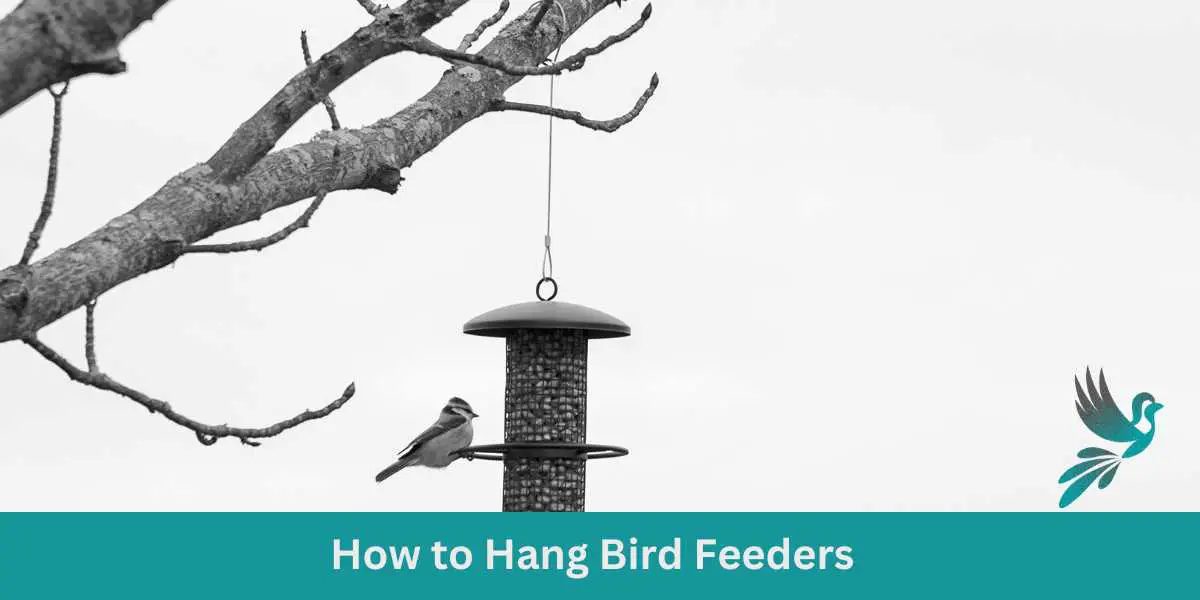Are you interested in attracting birds to your garden? One easy way to do so is by hanging bird feeders. Not only will you be able to enjoy the beauty of these feathered creatures, but you’ll also be providing them with a source of food, especially during the colder months when natural food sources can be scarce.
However, if you’re new to bird feeding, you might be wondering how to hang bird feeders properly. In this blog post, we’ll provide you with a beginner’s guide on how to hang bird feeders in your garden.
From deciding to hang one or multiple feeders to other ways of hanging feeders, we’ll cover everything you need to know to get started. So, let’s dive in and learn how to make your garden a welcoming haven for birds!
Key Takeaways on Hanging Bird Feeder
- Choosing a suitable location to hang a bird feeder away from predators is key to ensure the safety of both birds and humans.
- Hang a bird feeder with an appropriate hanger, such as hooks, poles, and chains.
- Other methods for hanging bird feeders include shepherd’s hooks, deck hangers, suction cups, pole systems, wall brackets, bird feeder poles, and overhead hangers.
Installing bird feeders
Hanging bird feeders is a wonderful way to attract birds to your backyard and provide them with a source of food. However, it is important to hang the bird feeder safely and securely to prevent them from falling or being knocked down by wind, animals or other factors.
Here’s how to hang a bird feeder:
Choose a location
The first step in hanging bird feeders is to choose a suitable location. It should be a spot that is visible from your home, but also away from areas where predators may be lurking. You should also consider placing your bird feeders near cover birds can use to hide from predators.
Keep in mind though that nearby branches provide hiding places and jumping off points for squirrels and other animals. Use squirrel-proof feeders to protect your feathered friends.
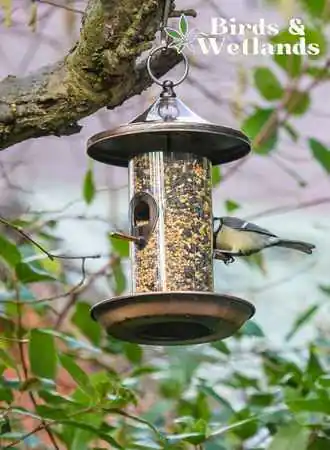
Select a hanger
Next, you’ll need to choose a hanger that will be able to support the weight of the bird feeder as the birds land. There are many types of hangers available, including bird feeder hooks, poles, and chains. Whichever type you choose, ensure that it is strong and durable enough to support the weight of the bird feeder, especially if it is a larger feeder.
In most cases, most feeders don’t need extra hardware or hanging accessories such as a pulley system but some may need an extra S-shaped hook for hanging.
Install the hanger
Once you’ve selected your hanger, you’ll need to install it in the chosen location. If you’re using a hook, you can simply screw it into a wooden post or hang it from a tree branch. If you’re using a pole or chain, you may need to dig a hole and cement the pole in place to ensure it remains upright.
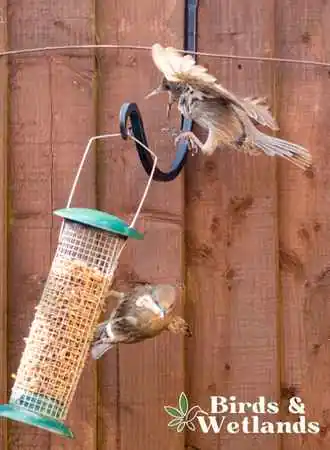
Attach the bird feeder
Now it’s time to attach the bird feeder to the hanger. Some feeders come with hooks or chains already attached, while others may require you to add your own. Ensure that the feeder is securely fastened to the hanger to prevent it from falling from the sturdy branch.
Fill the bird feeder
Fill your hanging feeder with birdseed or other appropriate food for the birds you wish to attract. Ensure that the feeder is always kept clean and topped up with food to encourage birds to return.
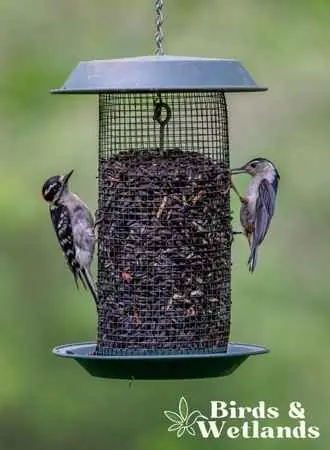
Do you need to hang more than one feeder in your garden or backyard?
Feeding birds is one of the joys of having a garden. But bird watchers often face a dilemma — hanging one feeder or multiple ones? Hanging one or multiple feeders depends on a few factors, including the size of your garden, the types of birds you want to attract, and how much food you want to provide.
Generally, having many feeders can be a good idea if you have a large garden or backyard. Birds tend to be territorial and may not want to share a feeder with other birds, especially if it’s a popular food source. By having multiple feeders spread throughout your garden, you can help ensure that all birds have access to food without competing with each other.
Additionally, having multiple feeders can help you attract a wider variety of bird species. Different types of birds have different feeding preferences, so by offering a variety of foods and feeder styles, you can increase the chances of attracting a diverse group of feathered visitors.
For example, some birds such as blue jays prefer to feed from tube feeders, while different birds prefer platform feeders or suet feeders. By having a mix of different feeders, you can cater to a range of feeding preferences.
Of course, the number of feeders you should hang also depends on how much food you want to provide. If you’re only interested in attracting a small number of birds, or if you have a limited amount of space in your garden, then a single feeder may be sufficient.
On the other hand, if you have a large feeding area or garden space and want to attract as many birds as possible, then hanging several feeders can be a good idea. You should place one feeder far from other feeders to prevent overcrowding.
What are other ways to hang feeders than hanging them from tree branches?
Hanging feeders on tree branches is a classic method, but there are many other ways to hang bird feeders such as a hummingbird feeder that can make your yard or garden more attractive to birds.
Here are some other ways to hang bird feeders:
- Shepherd’s hooks are tall, vertical poles that can be placed in the ground anywhere in your yard. You can hang your feeders from the hooks on the top of the poles. They come in different heights and styles, so you can choose one that fits your needs.
- Deck hangers are hooks that can be attached to the railing of your deck or porch. They allow you to hang feeders close to your house, where you can easily observe the birds.
- If you have a window that faces your yard or garden, you can attach more suction cups or suction mounts to the window and hang your window mounted bird feeders from them. You can also use window hangers which allows you to watch the birds eat. But beware of the risks of window collisions for this feeder setting.
- Pole kits are similar to shepherd’s hooks, but they come with multiple hooks that can be hung at different heights. This allows you to hang several feeders in one area, creating a bird feeding station.
- Use a wall bracket. If you have a solid structural wall or fence in your yard, you can attach a bracket to it and hang your feeder from it. This can add a decorative touch to your yard while providing food for birds.
- Bird feeder poles are specifically designed for hanging bird feeders. They come with hooks or platforms that allow you to hang multiple feeders at once.
- Overhead hangers are hooks that hang from an overhead structure such as a pergola or arbor. They allow you to hang feeders in a shaded area where birds can feed comfortably.
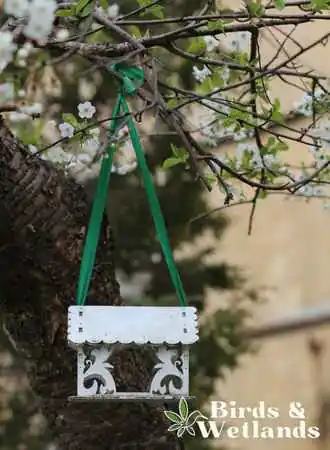
How to choose the best spots for placing bird feeders
Hanging a bird feeder can be a wonderful addition to any backyard or outdoor space, providing an opportunity to observe and enjoy a variety of bird species up close. However, choosing the right location for your bird feeder is crucial to its success.
Here are some tips to help you choose the best location for your bird feeder:
Consider the birds you want to attract.
Different bird species have different preferences when it comes to food and habitat. Some birds prefer open spaces, while others prefer trees or shrubs for cover. Some birds are ground feeders, while others prefer to feed from above.
Before selecting a location for your bird feeder, research the bird species you want to attract and their preferred habitat. You can also attract more birds if you provide them bird baths.
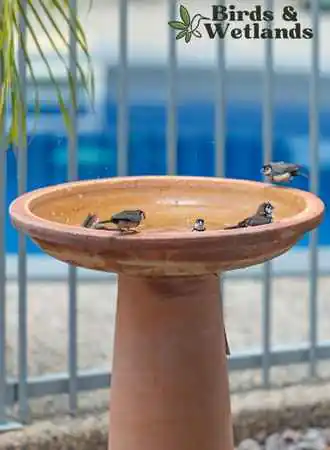
Choose a safe location for your bird feeders.
Your bird feeder should be in a location that is safe for both the birds and yourself. Ideally, the location should be out of reach of predators, such as cats, raccoons, or squirrels. It should also be in a place where it won’t interfere with human activities, such as doorways or walkways.
If you’re hanging your feeder from a tree branch, make sure the branch is strong enough to support the weight of the feeder and any visiting birds.
Use squirrel baffles to prevent squirrels from accessing your feeders. Moreover, use feeders that keep larger birds away but are easily accessible by smaller birds.
Place feeders in sheltered locations.
Birds need natural shelter from windy storms and other dangerous weather conditions. Try to locate your bird feeder near trees, shrubs, or other natural covers that can provide shelter for the birds. This will also provide a natural setting where the birds feel comfortable and minimize spill seed. Shaded locations also protect seed and other bird foods from spoilage.
For hummingbird feeders or nectar feeders, they should be placed in a location with protection against the wind and that provide jumping off points.
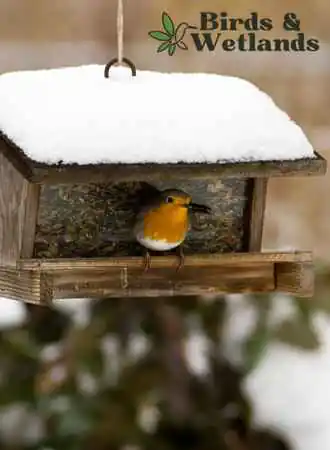
Keep feeders visible for birds and clean them regularly.
To fully enjoy your new feeder, position feeders in away that allows for easy viewing. Ideally, the location should be visible from a window or a comfortable seating area where you can watch the birds without disturbing them.
Feeders are naturally messy so you need to clean them regularly. Remove any uneaten seeds or bird food to avoid attracting pests and other insects.

